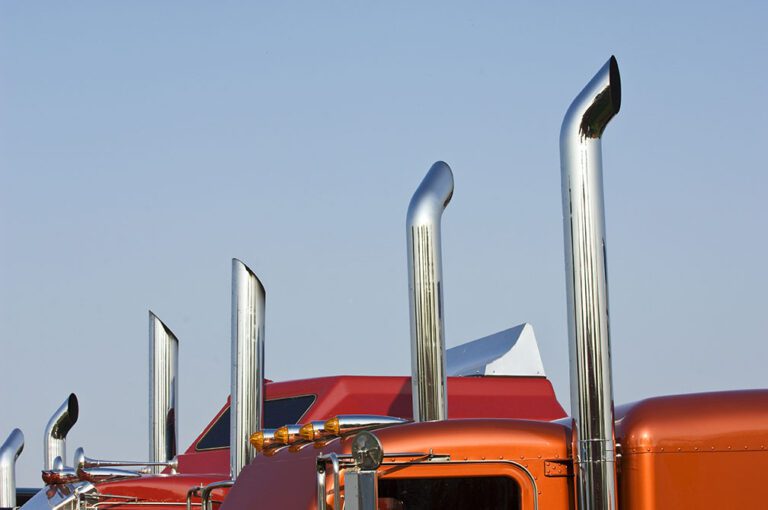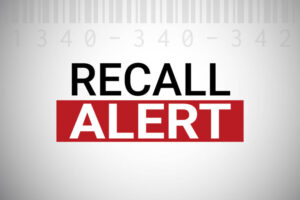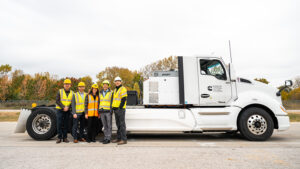WASHINGTON — The U.S. Environmental Protection Agency (EPA) is proposing a new and stronger set of greenhouse gas standards for heavy-duty vehicles for model years 2027 through 2032, building from the “Phase 2” greenhouse gas standards established in 2016.
The agency made the announcement on Wednesday, April 12.
This comes on the heels of a December 2022 announcement that the EPA finalized its new national clean air standards to cut smog-and soot-forming emissions from heavy-duty trucks beginning with model year 2027. That action was the first under EPA’s three-stage Clean Trucks Plan
The newest “Phase 3” greenhouse gas standards “would significantly reduce carbon emissions from heavy-duty vehicles and, through the increased use of zero-emission vehicle technology projected in the proposal, would also reduce emissions of smog and soot-forming pollutants and help to address the challenges of global climate change and air pollution in communities near major roadways,” according to an EPA news release.
EPA last revised the greenhouse gas standards for on-highway heavy-duty trucks and engines in 2016 under the “Phase 2” greenhouse gas program.
Those standards are on track to achieve greenhouse gas reductions from medium-and heavy-duty vehicles in model year 2021 through 2027, according to the EPA.
Reaction to the proposal has come swiftly from trucking industry leaders.
Todd Spencer, president of the Owner-Operator Independent Drivers Association, called it a “regulatory blitz on small-business truckers.”
“The latest proposal comes on the heels of a hurried NOx emissions rulemaking finalized in December, along with a California waiver mandating sales of electric trucks,” Spencer continued. “Today’s announcement is a blatant attempt to force consumers into purchasing electric vehicles while a national charging infrastructure network remains absent for heavy-duty commercial trucks.”
Spencer said that professional drivers are skeptical of electric vehicle (EV) costs, mileage range, battery weight and safety, along with charging time and availability.
“It’s baffling that the EPA is pushing forward with more impractical emissions timelines without first addressing these overwhelming concerns with electric (commercial motor vehicles) CMVs,” he said. “The pursuit of this radical environmental agenda in conjunction with an anticipated speed limiter mandate will regulate the safest and most experienced truckers off the road.”
Chris Spear, president and CEO of the American Trucking Associations (ATA), said that the trucking industry shares “the goal of reducing greenhouse gas emissions and improving fuel efficiency and believes any regulation must be practical, achievable and based on sound science. Our members have a long history of adopting the cleanest emissions technology on the road today and are making the necessary investments to support a decarbonized future.”
Spear said that while the standards are directed at manufacturers, it is fleets — the customers and end-users of this equipment — who will ultimately determine their level of success.
“The Phase 3 standards must take into account the complex challenges and operating conditions facing motor carriers as we manage the transition to a zero-emission future while simultaneously moving more than 72% of the economy’s freight,” he said. “As we review the proposed rule, ATA will remain engaged in the regulatory process to ensure the agency arrives at a regulation that has realistic equipment adoption timelines, is technologically feasible, and will not cause additional inflationary pressures if finalized.”
Spear also addressed the agency’s decision to reopen its Phase 2 regulation that was finalized in 2016:
“We are extremely disappointed that EPA has chosen to reopen the Phase 2 regulation, which had been set for years. To make the plans and investments necessary for a successful transition, our industry needs regulatory certainty — not whimsical changes of mind from year to year,” he said. “Our industry has always found ways to partner with EPA on regulations that are tough but achievable. If EPA wants us to remain a willing participant, their going back and changing what was already agreed upon is not how to do it.”
What vehicle types are covered by the proposal?
The proposed Phase 3 rulemaking applies to heavy-duty vocational vehicles, such as delivery trucks, refuse haulers, public utility trucks, transit, shuttle and school buses, along with tractors, such as day cabs and sleeper cabs.
Overview of proposed standards
EPA’s proposal includes new and stronger greenhouse gas standards that phase in over model years 2027 through 2032.
The proposed program revises the model year 2027 standards to be more stringent than the existing Phase 2 greenhouse gas standards for vocational vehicles and day cab tractors. It also introduces new standards for vocational vehicles and day cab tractors that become more stringent every model year from 2028 through 2032. For sleeper cab tractors, the proposed Phase 3 program introduces new standards in model year 2030 that increase in stringency in model years 2031 and 2032.
“The proposed Phase 3 program maintains the flexible structure created in the Phase 2 greenhouse gas program, which is effectively designed to reflect the diverse nature of the heavy-duty industry,” according to the EPA news release.
Under that structure, the proposed standards do not mandate the use of a specific technology and EPA expects internal combustion engine and zero-emission vehicle (ZEV) technologies will both play important roles in reducing greenhouse gas emissions.
Like the Phase 2 greenhouse gas program, these standards include emission standards that are differentiated by vehicle type and use, as well as an averaging, banking and trading program that allows manufacturers to trade credits, bank credits for future years and average credits in meeting the standards.
Projected mix of technologies
The proposed standards are performance-based, allowing each manufacturer to choose what set of emissions control technologies is best suited for their vehicle fleet to meet the standards.
EPA projects that one potential pathway for the industry to meet the proposed standards would be through:
- 50% ZEVs for vocational vehicles in model year 2032, which includes the use of battery electric and fuel cell technologies.
- 34% ZEVs for day cab tractors in model year 2032, which includes the use of battery electric and fuel cell technologies.
- 25% ZEVs for sleeper cab tractors in model year 2032, which primarily includes the use of fuel cell technologies.
These projections are even higher for many vehicle types.
Building on momentum
The proposed standards align with and support the commitments and billions of dollars’ worth of investments from trucking fleets, vehicle manufacturers, and U.S. states as they plan to increase the use of zero-emissions technologies in heavy-duty fleets. As these technologies have been advancing, battery costs have continued to decline.
Early ZEV models are in use today for some heavy-duty applications and are expected to expand to many more.
“These ongoing technological innovations allow for appropriate and feasible reductions in greenhouse gas emission standards considering cost, lead time, and other factors,” the news release stated. “The Bipartisan Infrastructure Law and the Inflation Reduction Act provide unprecedented investments to support the development of and market for ZEV technologies and their infrastructure.”
In addition, multiple states have acted to accelerate the adoption of heavy-duty ZEVs, including California’s action to set ZEV sales requirements under its Advanced Clean 2 Regulatory Announcement Trucks program (requirements that multiple other states have moved to adopt), as well as the signing of the Multi-State Memorandum of Understanding by 17 states and the District of Columbia to establish specific goals for increasing heavy-duty ZEVs.
Climate and air quality urgency
“Greenhouse gas emissions have significant impacts on public health and welfare,” EPA officials said, noting that “transportation is the single largest U.S. source of greenhouse gas emissions, making up 27% of total greenhouse gas emissions.”
Within the transportation sector, heavy-duty vehicles are the second largest contributor, at 25% of all transportation sources.
“The proposed standards for heavy-duty vehicles would avoid approximately 1.8 billion metric tons of greenhouse gas emissions from 2027 through 2055, making an important contribution to efforts to limit climate change and its impacts such as heat waves, drought, sea level rise, extreme climate and weather events, coastal flooding and wildfires,” according to the EPA. “These greenhouse gas reductions would benefit all U.S. residents, including populations such as people of color, low-income populations, indigenous peoples, and/or children that may be especially vulnerable to various forms of damages associated with climate change.”
The proposed Phase 3 program is expected to increase use of zero-emission heavy-duty vehicles, which would reduce emissions of smog and soot forming pollutants by:
- 650 tons of particulate matter.
- 72,000 tons of nitrogen oxides.
- 21,000 tons of volatile organic compounds, compared to 2055 levels without the proposal.
The proposed standards would reduce air pollution near roads as well, the EPA noted.
“Near-roadway communities are often low income or communities of color, and children who attend school near major roads are disproportionately represented by children of color and children from low-income households,” the news release stated. “These populations would benefit most directly from the projected emission reductions. Reducing these emissions would also provide cleaner air for communities across the country, prevent health issues like asthma, and ultimately save money, lives and trips to the hospital.”
Benefits
EPA estimates that the total benefits of this proposal far exceed the total costs, by as much as $320 billion.
“Society would realize approximately $87 billion in climate benefits and up to $29 billion in benefits from fewer premature death and serious health effects such as hospital admissions due to respiratory and cardiovascular illnesses, along with approximately $12 billion in reduced reliance on oil imports,” according to the EPA.
Costs and consumer savings
The EPA claims that heavy-duty vehicle purchasers would see approximately $250 billion in savings associated with less fuel used and less vehicle maintenance and repairs needed through 2055.
EPA estimates the cost of compliance with the program for manufacturers would be only about $6 billion, after accounting for an estimated $3 billion in cost reductions from battery tax credits provided by the Inflation Reduction Act.
After accounting for the vehicle purchase tax credits provided under the Inflation Reduction Act, the EPA estimates the typical buyer of a new heavy-duty zero-emission vehicle would:
- Pay an average of between $900 and $11,000 more in upfront costs for a model year 2032 vocational vehicle ZEV than for a conventional, including the cost of electric vehicle charging infrastructure, but recoup these costs in 3 years or less through yearly operational savings.
- Pay an average of $17,000 more in upfront costs for a model year 2032 day cab tractor ZEV than for a conventional, including the cost of electric vehicle charging infrastructure, but recoup these costs in three years or less though yearly operational savings.
- Pay an average of $15,000 more in upfront costs for a model year 2032 sleeper cab tractor ZEV than for a conventional but recoup these costs in seven years or less though yearly operational savings.
The Trucker News Staff produces engaging content for not only TheTrucker.com, but also The Trucker Newspaper, which has been serving the trucking industry for more than 30 years. With a focus on drivers, the Trucker News Staff aims to provide relevant, objective content pertaining to the trucking segment of the transportation industry. The Trucker News Staff is based in Little Rock, Arkansas.















I’m an OTR driver. I’m working with a small team to bring the diesel engine to functional noncombustion status, using Heat. simple retrofit, once in commercialization. benefits: Cheaper to run by a large margin, no GreenHouseGas emissions, increased HP, longer engine life.
secret: Charles Law, Thermodynamics of heat + pressure. Need industry advocacy to swing pendulum forward, to the politicians, and admin.